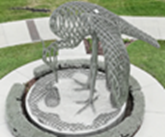ArcGIS is a scalable 3D system of record that allows you to create, store, manage, and share 3D content across a variety of devices. With ArcGIS, you can generate 3D content from existing data sources, such as 2D data, lidar, imagery or using procedural rules. Accessing ready-to-use content is available through ArcGIS itself and Esri partners. 3D content is handled through several layer types that reference a 3D data source which can be local or on the web.
The following layer types are available to store and manage 3D data across the ArcGIS system:
| Layer type | When to use | Example |
|---|---|---|
A layer that supports fast visualization of the elevation data at many levels of detail from local to global scale. | Use to add elevation to your 3D scene. You can create a web elevation layer to share on the web. |  |
A layer that represents geographic features as individual objects. Feature layers support point, line, polygon, multipatch, and 3D object types. | Drape point, line, and polygon features on the surface or use symbology to create 3D features. Multipatch and 3D object feature layers should be used to store and manage complex 3D geometries including textures and material properties. |  |
3D layers can be optimized for displaying large amounts of 3D data at different levels of detail. Depending on the data source type of 3D Scene Layer (i3s) or 3D tiles, different 3D layer types can be defined. 3D tiles represent mesh, Gaussian splat or 3D object types, whereas scene layers represent point, mesh, point cloud, voxel, building, and 3D object types. | Use 3D layers when you want to optimize visualizing large amounts of 3D content across desktop, web, and mobile clients. |  |
The 3D layer is recommended when working with large amounts of 3D data across the ArcGIS system. Several types of 3D layers are available tailored to various 3D data sources.
| 3D layer type | Example |
|---|---|
Represents objects such as buildings that are explicitly modeled in three dimensions with support for advanced materials and textures. |  |
Displays large amounts of point data symbolized by 3D symbols such as all trees of a county. |  |
Supports the display of multiple level-of-detail reality meshes. |  |
Displays high-fidelity photorealistic reality capture. |  |
Provides fast display of large volumes of symbolized and filtered point cloud data. |  |
Allows effective visualization and filtering of 3D building models derived from building information models (BIM). |  |
Supports the display, sharing, and analysis of multidimensional spatial and temporal information in a 3D volumetric visualization. |  |
Point, building, and 3D object layer types can have an associated feature layer. 3D point layers are derived from point data, and 3D object and building layers are derived from multipatch data or a 3D object feature layer. When sharing scene layers to ArcGIS Enterprise or ArcGIS Online, with the caching on server option set, a point, building, or 3D object scene layer with an associated feature layer is created. Through this association, you can use additional capabilities on the web layer such as querying statistics dynamically or editing attributes and geometry.
Application-specific layer types, such as the KML layer and the LAS dataset layer in ArcGIS Pro, need to be converted to a feature layer or a scene layer to share the layer across the ArcGIS system.